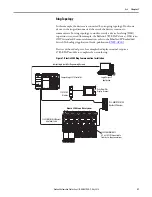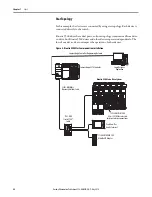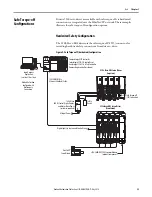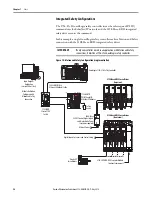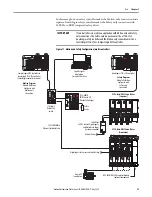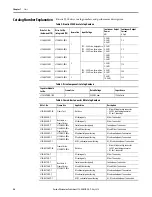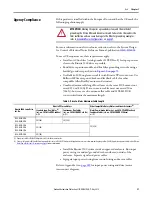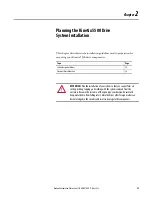
34
Rockwell Automation Publication 2198-UM001D-EN-P - May 2014
Chapter 2
Planning the Kinetix 5500 Drive System Installation
Enclosure Selection
This example is provided to assist you in sizing an enclosure for your
Kinetix 5500 drive system. You need heat dissipation data from all components
planned for your enclosure to calculate the enclosure size (refer to
With no active method of heat dissipation (such as fans or air conditioning)
either of the following approximate equations can be used.
If the maximum ambient rating of the Kinetix 5500 drive system is 50 °C
(122 °F) and if the maximum environmental temperature is 20 °C (68 °F), then
T=30. In this example, the total heat dissipation is 416 W (sum of all
components in enclosure). So, in the equation below, T=30 and Q=416.
In this example, the enclosure must have an exterior surface of at least 2.99 m
2
. If
any portion of the enclosure is not able to transfer heat, do not include that value
in the calculation.
Because the minimum cabinet depth to house the Kinetix 5500 system (selected
for this example) is 300 mm (11.8 in.), the cabinet needs to be approximately
1500 x 700 x 300 mm (59.0 x 27.6 x 11.8 in.) HxWxD.
1.5 x (0.300 x 0.70) + 1.5 x (0.300 x 2.0) + 1.5 x (0.70 x 2.0) = 3.31 m
2
Because this cabinet size is considerably larger than what is necessary to house the
system components, it can be more efficient to provide a means of cooling in a
smaller cabinet. Contact your cabinet manufacturer for options available to cool
your cabinet.
Metric
Standard English
Where T is temperature difference between inside air and
outside ambient (°C), Q is heat generated in enclosure
(Watts), and A is enclosure surface area (m
2
). The exterior
surface of all six sides of an enclosure is calculated as
Where T is temperature difference between inside air and
outside ambient (°F), Q is heat generated in enclosure
(Watts), and A is enclosure surface area (ft
2)
. The exterior
surface of all six sides of an enclosure is calculated as
A = 2dw + 2dh + 2wh
A = (2dw + 2dh + 2wh) /144
Where d (depth), w (width), and h (height) are in meters.
Where d (depth), w (width), and h (height) are in inches.
A =
0.38Q
1.8T - 1.1
A =
4.08Q
T - 1.1
A =
0.38 (416)
1.8 (30) - 1.1
= 2.99 m
2


